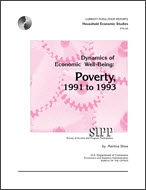Dynamics of Economic Well-Being: Poverty, 1991 to 1993
Dynamics of Economic Well-Being: Poverty, 1991 to 1993
Note: All demographic surveys, including the Survey of Income and Program Participation (SIPP), are affected by undercoverage of the population. This undercoverage results from missed housing units and missed persons within sample households. Compared to the level of the 1980 Decennial Census, overall undercoverage in SIPP is about 7 percent. Undercoverage varies with age, sex, and race. For some groups, such as 20 to 24 year old Black males, the undercoverage is as high as 27 percent compared to the census. It is important to note that the survey undercoverage is an addition to the decennial census undercoverage, which in 1980 was estimated to be about 1 percent overall and about 8.5 percent for Black males. The weighting procedures used by the Census Bureau partially correct for the bias due to undercoverage. However, its final impact on estimates is unknown.
Introduction
This report uses data from SIPP to examine the incidence of poverty at a point in time and over a 32-month period. It presents data from the complete panel file of the 1991 SIPP which covers the time period from October 1990 through August of 1993.
SIPP enables comparisons of poverty rates among groups of persons of different demographic and socioeconomic characteristics. It also can be used to study the distribution of poverty spell durations. The panel file contains monthly information on income as well as on many other characteristics which can vary over the panel, such as family and labor force status. Efforts were made during the life of the panel to follow persons who moved to ensure that the sample remained representative of the noninstitutional population of the United States. Persons are characterized by the income and poverty status of their respective family unit based on living arrangements each month during the period of study.
It should be noted that longitudinal estimates presented here are based on persons who either were interviewed in all waves of the reference period or for whom imputed wave information exists.1 Insofar as persons with missing actual or imputed wave information differed in their experience of poverty from those who did not, these longitudinal estimates may be biased.
_______________
1 A ‘‘missing wave imputation’’ procedure was used for persons who missed an interview but had completed interviews before and after the missing wave.
Others in Series
Publication
Publication
Publication




